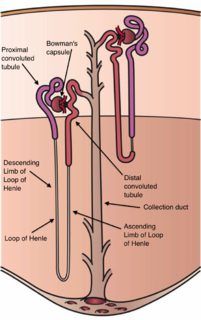
The nephronthe minute or microscopic structural and functional unit of the kidney. It is composed of a renal corpuscle and a renal tubule. The renal corpuscle consists of a tuft of capillaries called a glomerulus and a cup-shaped structure called Bowman's capsule. The renal tubule extends from the capsule. The capsule and tubule are connected and are composed of epithelial cells with a lumen. A healthy adult has 1 to 1.5 million nephrons in each kidney. Blood is filtered as it passes through three layers: the endothelial cells of the capillary wall, its basement membrane, and between the foot processes of the podocytes of the lining of the capsule. The tubule has adjacent peritubular capillaries that run between the descending and ascending portions of the tubule. As the fluid from the capsule flows down into the tubule, it is processed by the epithelial cells lining the tubule: water is reabsorbed and substances are exchanged ; first with the interstitial fluid outside the tubules, and then into the plasma in the adjacent peritubular capillaries through the endothelial cells lining that capillary. This process regulates the volume of body fluid as well as levels of many body substances. At the end of the tubule, the remaining fluid—urine—exits: it is composed of water, metabolic waste, and toxins.

The collecting duct system of the kidney consists of a series of tubules and ducts that physically connect nephrons to a minor calyx or directly to the renal pelvis. The collecting duct system is the last part of nephron and participates in electrolyte and fluid balance through reabsorption and excretion, processes regulated by the hormones aldosterone and vasopressin.

Intermediate mesoderm or intermediate mesenchyme is a narrow section of the mesoderm located between the paraxial mesoderm and the lateral plate of the developing embryo. The intermediate mesoderm develops into vital parts of the urogenital system, as well as the reproductive system.

WNT4 is a secreted protein that in humans is encoded by the Wnt4 gene, found on chromosome 1. It promotes female sex development and represses male sex development. Loss of function can have serious consequences, such as female to male sex reversal.

Paired box gene 2, also known as Pax-2, is a protein which in humans is encoded by the PAX2 gene.

Protein Wnt-5a is a protein that in humans is encoded by the WNT5A gene.

Protein Wnt-3a is a protein that in humans is encoded by the WNT3A gene.

Protein Wnt-7a is a protein that in humans is encoded by the WNT7A gene.

Inversin is a protein that in humans is encoded by the INVS gene.

Cadherin-16 is a protein that in humans is encoded by the CDH16 gene.

Proto-oncogene protein Wnt-3 is a protein that in humans is encoded by the WNT3 gene.

Protein odd-skipped-related 1 is a transcription factor that in humans is encoded by the OSR1 gene. The OSR1 and OSR2 transcription factors participate in the normal development of body parts such as the kidney.

Protein Wnt-10b is a protein that in humans is encoded by the WNT10B gene.

Protein Wnt-11 is a protein that in humans is encoded by the WNT11 gene.

Protein Wnt-2b is a protein that in humans is encoded by the WNT2B gene.

Protein Wnt-9a is a protein that in humans is encoded by the WNT9A gene.

Protein Wnt-16 is a protein that in humans is encoded by the WNT16 gene. It has been proposed that stimulation of WNT16 expression in nearby normal cells is responsible for the development of chemotherapy-resistance in cancer cells.

Protein Wnt-5b is a protein that in humans is encoded by the WNT5B gene.

Protein Wnt-8b is a protein that in humans is encoded by the WNT8B gene.

Protein Wnt-9b is a protein that in humans is encoded by the WNT9B gene.

















